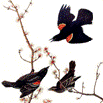Center, Internet, Wildlife Damage Management

Bird Control Seminars Proceedings
Document Type
Article
Date of this Version
November 1979
Abstract
The Rose-ringed parakeet (Psittacula krameri [Scopdi]) has been reported (Roberts, 1974; Bashir, 1978; Beg, 1978; and DeGrazio, 1978) as a serious bird pest of maize, sunflower, rape seeds, and fruit crops, particularly citrus, mangoes, and guavas, in Pakistan. Estimated annual losses to maize grown for seed alone amount to about 97,000 tons, worth about Pak. Rs. 150 million or US $15 million (Roberts, 1978). Paradoxically, this handsome bright green parakeet is highly esteemed in the pet trade; and limited numbers are also marketed locally and sometimes exported to neighboring countries, particularly the Arab Gulf Emirates, as caged pets. Traditional control methods aimed at scaring or chasing birds from the crops, usually with noise-making devices, are costly; furthermore, they have largely been unsuccessful and time consuming because they require human patrolling before and after normal working hours. They provide at best only temporary relief. The aim of this study was to develop a new decoy trap based on the Modified Australian Crow Trap (MAC), which we propose to call the PAROTRAP, and to evaluate its effectiveness and potential in capturing live parakeets in the field as a possible solution to the parakeet problem, as well as promoting the economic exploitation of trapped parakeets for the pet trade. The study was undertaken during March and June 1979 as a part of the UNDP/FAO Project No. PAK/71/554, assisting Pakistan Vertebrate Pest Control Centre in developing and improving control techniques to prevent or reduce bird damage to important crops. Our earlier trials showed that parakeets could be induced to enter a conventionally designed MAC trap, and that after some time they learned how to escape from it. Therefore, a series of minor modifications were introduced and field tested.

